
Exercise is Trump Card for Healthy Aging
When I see older patients for the first time, I can quickly tell who exercises regularly. They move more quickly, have better posture, and slimmer waistlines. Recently I met a woman in her mid-90s. She survived cancer more than 15 years ago, takes no medications, and lives independently. Not surprisingly, she takes a walk every day, going to a local shopping mall when the weather is poor.
As a general internist with an interest in geriatrics, I enjoy partnering with patients to improve their quality of life and longevity. For seniors (age 65 and over), regular exercise tops the list of my recommendations as the best way to maintain their independence and prevent many of the health risks associated with getting older, such as a heart attack, stroke, and falls. We also discuss “exercise tolerance,” which refers to how far they can walk without getting tired, becoming short of breath or having to stop. As a minimal goal, most people should be able to walk four blocks or climb two flights of stairs without difficulty.
I encourage patients to start an exercise program with an enjoyable activity so it can easily become part of daily life. In the Pacific Northwest, an indoor component helps to maintain consistency during our dark and rainy seasons. An exercise partner (spouse or friend) also can make activities more enjoyable. For many patients, walking is a good choice because it requires no gym membership or special equipment. While 30-60 minutes of daily exercise is optimal for health benefits, starting slowly is fine. Some people can exercise for only five minutes initially and need months to build up to their goal.
Regular daily exercise helps to prevent cardiovascular disease and stroke by improving blood pressure and cholesterol levels. In addition, patients who introduce exercise into their treatment plan for chronic diseases have better outcomes than patients who are not physically active. For instance, studies demonstrate that exercise can alleviate arthritis pain because it helps to keep joints lubricated. Besides walking, good choices for seniors include swimming, dancing, and yard work for endurance, light weight training for muscle strength, tai chi for balance, and yoga for flexibility.
By improving balance, mobility, and reaction time, exercise is also the most effective strategy to prevent falls – one of the greatest threats that seniors face to living independently. A good home exercise to assess and improve balance is to see how long you can stand on one leg with your eyes closed:
- For your safety, start by having a chair or person nearby for support if you feel unsteady.
- Stand barefoot on a flat, hard surface, lift one foot about six inches off the floor, bend your knee at a 45-degree angle and start timing.
- Hold this position as long as you can without swaying, falling or opening your eyes.
- Stop timing if the raised foot begins to lower or touch the ground, if you sway or if you need to open your eyes.
- Repeat daily with the goal of keeping your foot lifted for 30 seconds to two minutes.
With any new exercise, talk to your primary care doctor if you have specific health concerns or to determine if modifications are needed based on your health history. To reduce risk of injury, the National Institute of Aging reminds seniors to follow these basic safety tips while exercising: begin slowly with low-intensity exercises, warm up and cool down properly, pay attention to your surroundings, dress appropriately and drink plenty of water. For additional fitness ideas and safety tips, visit the institute’s Go4Life website.
The bottom line is that light daily exercise is not only safe for seniors. It is a trump card for enjoying a longer, healthier, and more independent life.
 Jennifer Azen, M.D., is a board-certified internal medicine physician at the UW Neighborhood Kent/Des Moines Clinic. For more information, call 206.520.5000 or visit uwmedicine.org/uwnc.
Jennifer Azen, M.D., is a board-certified internal medicine physician at the UW Neighborhood Kent/Des Moines Clinic. For more information, call 206.520.5000 or visit uwmedicine.org/uwnc.
One Thought on “Exercise is Trump Card for Healthy Aging”
On September 9, 2014 at 8:49 AM, John M. Rensberger said:
Hi Jennifer,
I enjoyed reading your recommendations on Exercise for Healthy Aging very much. I am 81 and have been walking 6 to 8 miles each day for many years, but haven’t tried your tip for improving balance and am going to do that.
I thought I would share what I do to motivate myself to keep up my walking. I keep a record of my calories burned each day in the application Lose It! that I run on my iPod Touch and match that with a goal I have set. This app converts my time walking each day to calories burned, and subtracts that from calories consumed. It’s so easy to record food quantities, which are converted automatically by Lose It! to calories. Each morning I weigh myself and find I can control my weight exactly by meeting my daily goal of calories burned. It’s fun, like playing a computer game, and a great motivator!
Comments are closed.